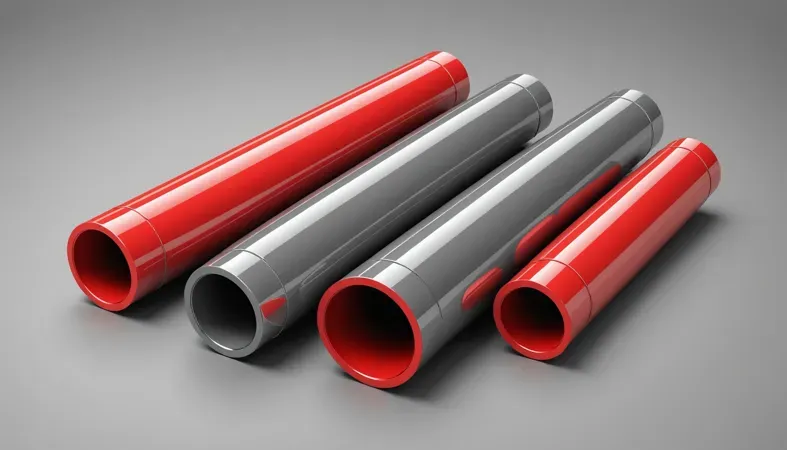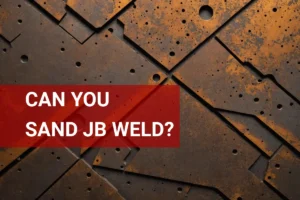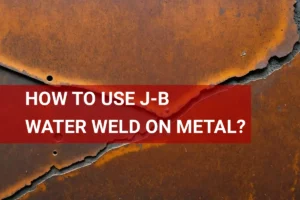Can You Paint JB Weld? Options, Tips, and Techniques
Published on: May 1, 2025 | Last modified: March 4, 2025
By: Tyler James
JB Weld is a strong epoxy adhesive. It’s used for bonding metal, wood, ceramic, and more.
If you’re curious about can you paint jb weld, then you should know it’s crucial to get this right. I’ve seen issues arise when people skip this step. Checking if your JB Weld surface can be painted ensures a clean, professional look.
In this guide, I’ll cover essential topics like what JB Weld is, different types available, how to prep and paint it, precautions to take, suitable paint options, factors influencing your paint job, unique issues you might face, tips on aftercare and inspection, as well as the advantages of using JB Weld. Plus, we’ll talk about alternatives for similar results and address common questions. Let’s dive into the details!
Contents
- Can You Paint JB Weld?
- What is JB Weld?
- Types Of JB Weld
- Prerequisites
- Precautions
- Steps to Prepare and Paint JB Weld
- Types Of Paint for JB Weld
- Factors Affecting Painting JB Weld
- Unique Issues
- Aftercare, Inspection, and Advanced Tips for Painting JB Weld
- Tips for Achieving a Professional Finish on Painted JB Weld
- Advantages Of Using JB Weld
- Industry Uses for JB Weld
- Alternatives for Achieving Similar Results As JB Weld
- Frequently Asked Questions (FAQs)
- Conclusion
- Additional Reading
Can You Paint JB Weld?
Yes, you can paint JB Weld. It’s not the easiest, but with proper prep, like sanding and cleaning, it works well. Use a high-quality primer followed by paint for the best results. Make sure to wait at least 24 hours after curing.
What is JB Weld?
JB Weld is a high-strength epoxy adhesive for metal, wood, plastic, and ceramic repairs. This two-part system consists of a resin and a hardener. It forms a strong bond with a tensile strength of about 3,968 psi (Pounds Per Square Inch) or 27.4 MPa (Megapascals). After hardening, JB Weld resists most fuels, oils, and chemicals, making it versatile for various applications.
Can you paint JB Weld? This question often arises. I’ve found that while JB Weld creates a solid, durable base, its surface texture may need some prep work for effective painting. Sanding it can improve paint adhesion and lead to better results.
I used it to fix a broken metal bracket on my bike. While applying JB Weld, I wondered if I could paint it to match my bike’s color. It’s important to consider how soon you can paint over it. Typically, waiting at least 15-30 minutes after it’s set, but before it fully cures, gives the best results. This approach helps maintain the epoxy’s bond while ensuring a better finish.
Types Of JB Weld
What are the different types of JB Weld, and can you paint each one? Let’s break it down.
-
Original JB Weld
This is standard epoxy for metal repairs. Yes, you can paint it. Let it cure for at least 15-24 hours, sand the surface lightly for better adhesion, and apply 1-2 coats of compatible paint for a smooth finish.
-
JB Quick Weld
This variant sets quickly, usually in 4-6 minutes. It’s great for fast fixes. You can paint it too. Wait 1 hour after application, then sand the surface lightly. Use a compatible paint with epoxy.
-
JB Marine Weld
This one’s designed for wet and underwater repairs and is durable against moisture. Painting is possible! Let it cure for 24 hours, sand the area, and then use marine-grade paint to withstand water and harsh conditions.
-
JB Plastic Weld
It’s specially made for bonding plastics. Perfect for plastic repairs. You can paint it as well. Allow it to cure for 4-6 hours, then use a plastic-compatible spray paint for best results.
-
High-heat JB Weld
This type withstands high temperatures, up to 1000°F (538°C). It’s ideal for exhaust systems. Yes, you can paint it! Cure it for 1-3 hours, sand lightly, and apply high-heat paint suitable for metal surfaces to prevent peeling.
So far we covered the various forms of JB Weld. Let’s look at the necessary requirements next.

Prerequisites
What do you need to prepare for painting JB Weld?
- High-Quality Primer: You need a primer like Rust-Oleum Automotive Primer. It’s essential for promoting paint adhesion on JB Weld surfaces.
- Marine-Grade Paint: Use products like Interlux Brightside Paint. It’s durable and designed for tough jobs, ensuring lasting color on JB Weld.
- Sandpaper (320 Grit): A 320-grit sandpaper, like 3M Wetordry, is necessary for smoothing the JB Weld surface before painting, enhancing the finish.
- Foam Applicator: Get a foam applicator like Wooster Pro. This ensures a smooth application without brush marks on JB Weld.
You should now have a good understanding of the necessary requirements and background information. In the next part, we’ll discuss safety measures.
Precautions
Let’s quickly explore essential precautions when painting with JB Weld.
- Ventilation: Ensure good airflow; use fans if needed. Adequate ventilation reduces fume exposure risks, which is essential for health.
- Protective Gear: Wear gloves and goggles; they protect against fumes and splashes. Use nitrile gloves and safety glasses while working.
- Surface Cleaning: Clean the area properly before painting; dust can ruin adhesion (Stickiness). I recommend using acetone for effective cleaning.
- Temperature Control: Work within 60-90°F (15-32°C); extreme temperatures affect paint curing and adhesion quality. Check your workspace conditions.
Always prioritize safety precautions; your well-being matters to me.
So far we covered safety measures to take. Let’s look at how to prepare and paint JB Weld next.
Steps to Prepare and Paint JB Weld
Here are the steps to effectively paint over JB Weld. Follow them closely for great results!
-
Inspect the Cure Time
First, ensure the JB Weld has fully cured. It typically takes about 15-24 hours for a strong hold, depending on conditions. Check the temperature; curing happens faster at warmer temperatures. If you’re in a colder area, allow a few extra hours for better adhesion.
Rushing the waiting period can lead to peeling later. Take your time with projects; patience pays off!
-
Clean the Surface
Next, clean the surface you’ll paint. Use a cloth soaked in isopropyl alcohol (70% or Higher) to wipe away dust and grease for a solid paint bond. This ensures the paint sticks and doesn’t bubble later.
From experience, thorough cleaning is key. Skipping it can create a visible mess on your weld line!
-
Sand the JB Weld
Sanding is essential for preparing JB Weld for paint. Use fine-grit sandpaper (Around 220 Grit or 1.5mm) to smooth the surface. Lightly buff until you achieve a rough texture. This helps the paint grip better and enhances adhesion. One crucial aspect of welding that requires particular attention to detail is the process known as B pressure welding.
I recommend sanding in one direction to keep it neat. This minimizes dust and makes cleanup easier later. It really makes a difference in your finish!
-
Apply Primer
Priming is crucial before painting. Use a high-quality primer designed for metals or epoxy. A thin, even coat helps the paint adhere and can prevent rust or corrosion. Always follow the manufacturer’s guidance on drying times.
From experience, using a spray primer results in a smoother finish. Just be sure to wear a mask to avoid fumes!
-
Paint the Surface
Now, let’s get to painting! Choose a paint compatible with your primer; acrylic enamel is usually a safe bet. Apply multiple light coats rather than one heavy coat, allowing adequate drying time between coats.
It’s tempting to apply thick paint, but that leads to runs. I learned this the hard way. Check the temperature and humidity for optimal paint performance!
-
Seal the Paint
Finally, seal your paint job for protection. Use a clear coat spray that matches your paint. This adds durability and gives your project a polished look. Wait for the paint to dry before applying the sealer.
This last step boosts the longevity of your work. A good seal helps prevent wear and tear!
We’ve wrapped up the steps for preparing and painting JB Weld here. Let us turn our attention to the paint types suitable for JB Weld.
Types Of Paint for JB Weld
Let’s explore the various paint types suitable for JB Weld: Acrylic, Enamel, Spray, Water-Based, and Oil-Based paints.
-
Acrylic Paints
Acrylic paints are water-based. They dry quickly, in about 15-30 minutes. Great for indoor projects, they adhere well to JB Weld, but ensure the surface is clean.
-
Enamel Paints
Enamel paints provide a tough finish and take up to 24 hours to dry. They’re resistant to scratching and weathering, making them ideal for outdoor JB Weld applications.
-
Spray Paints
Spray paints are easy to apply. You can find both spray enamels and acrylics. Depending on the type, they dry in 15 minutes to an hour. Look for labels that say “can you paint over JB Weld” for the best results.
-
Water-based Paints
Water-based paints are user-friendly and low in odor. These paints are great for indoor projects but require proper surface preparation to adhere effectively to JB Weld.
-
Oil-based Paints
Oil-based paints cure over several hours. They create a durable finish and resist moisture. Ensure JB Weld is clean since oil paints can sometimes struggle to bond properly.
Factors Affecting Painting JB Weld
What factors influence your ability to apply paint on JB Weld?
-
Surface Temperature
Temperature is crucial. Surfaces should be between 50°F (10°C) and 90°F (32°C) for optimal adhesion and curing.
-
Humidity Levels
High humidity negatively impacts painting. Levels above 70% can delay curing and reduce paint adhesion.
-
Curing Time Of JB Weld
Wait at least 15-24 hours after application. JB Weld fully cures in 24 hours, improving paint adherence.
-
Type Of Paint Used
Choosing the right paint is important. Use epoxy or enamel paints for the best results, as they adhere well to JB Weld.
-
Surface Texture
A rough surface provides better paint grip. Sanding JB Weld slightly (If Permissible) improves paint adherence.
Unique Issues
Let’s look at unique problems you might face with JB Weld.
-
Adhesion Problems
JB Weld needs a clean surface. If it’s dirty, it’ll fail. Clean the area thoroughly. Test the bond by applying pressure; if it peels, reapply correctly.
-
Color Matching
JB Weld’s color may not match your project. I recommend mixing a small amount of paint into the JB Weld before application to achieve your desired hue.
-
Longevity Of Paint
Paint doesn’t stick well on JB Weld over time. Use a primer designed for epoxy before applying paint. Wait at least 24 hours for the JB Weld to cure completely.
-
Exposure to Chemicals
Some chemicals can weaken JB Weld. Always check compatibility with the chemicals you plan to use. If you’re unsure, perform a spot test before applying it broadly.
-
Heat Resistance
JB Weld withstands heat up to 500°F (260°C). Exceeding this can cause failure. Monitor temperature if you’re using JB Weld in high-heat areas.
Aftercare, Inspection, and Advanced Tips for Painting JB Weld
Here are key details to ensure your JB Weld job lasts and looks great.
Aftercare Tips
After JB Weld cures—usually 15-24 hours—ensure it’s fully set at room temperature (Around 20°C or 68°F). Avoid exposing it to water or excessive moisture during the first week; damp environments may weaken its strength. Heat or high humidity can alter cure times, so keep it dry for optimal bonding. In welding, a thorough understanding of techniques such as hot pass in welding can significantly improve joint integrity.
Inspection Tips
Inspect JB Weld for bubbles or voids—these small bumps indicate a poor bond. Use the Johnson Tester Gauge to measure bond strength; ideal results should exceed 100 psi (680 Kpa). I also check edges and joints with sandpaper adherence tests; if it scrapes, that’s a bad sign.
Expert Tips
If this isn’t your first time painting JB Weld, consider prep work—use fine-grit sandpaper (Around 400 Grit) to enhance surface bonding. Be specific with your primer choices: a high-performance epoxy primer improves paint adhesion. Experiment with different drying techniques; controlled heating at 40-50°C (104-122°F) can accelerate and enhance coating outcomes.
Tips for Achieving a Professional Finish on Painted JB Weld
To get that polished look when painting JB Weld, consider these expert tips.
Surface Preparation
Start with a clean slate. Any dirt or grease can ruin adhesion. Use isopropyl alcohol to wipe the surface thoroughly.
Selecting the Right Paint
Not all paints work equally with JB Weld. Use epoxy or enamel paints for the best results. They bond better and provide a durable finish.
Test Colors Before Full Application
Mix small batches of paint to test colors before committing. This helps avoid mismatches that might ruin your project.
Optimal Drying Conditions
The environment matters! Dry in a space with controlled temperature (around 70°F or 21°C) and low humidity (under 50%) for best adhesion.
Final Touches with Clear Coats
Adding a clear coat after painting protects your work. Use a clear acrylic sealer, ensuring everything looks smooth and polished.
| Tip | Description |
|---|---|
| Surface Preparation | Thoroughly clean with isopropyl alcohol to ensure a strong bond. |
| Selecting Paint | Opt for epoxy or enamel for durability and better adhesion. |
| Color Testing | Test paint colors in small batches to avoid mismatches. |
| Drying Conditions | Aim for 70°F (21°C) and low humidity for optimal results. |
| Clear Coating | Seal the paint with a clear coat for longevity and shine. |
Advantages Of Using JB Weld
The primary benefit of JB Weld is its strong bond. It came in handy when I needed to fix a leaking metal pipe, saving me a costly replacement.
Additionally, it’s versatile and easy to use, making it perfect for various projects. You can paint over it, customize repairs, ensure a seamless finish, and achieve excellent durability.
Industry Uses for JB Weld
People use JB Weld for heavy-duty repairs, but it has many unique applications, such as:
- Automotive Repairs: JB Weld is popular for fixing metal parts like engine blocks. It withstands high temperatures and keeps the engine running smoothly.
- Plumbing Fixes: Use it to seal leaks in pipes. The epoxy bonds strongly, making it less likely to crack than traditional adhesives.
- Marine Applications: JB Weld can repair boat hulls. It’s resistant to saltwater, ensuring durability while you’re out on the water.
- Home Appliances: It’s great for fixing broken components in appliances. Painting over JB Weld helps it blend in with the original color, keeping your home looking sharp.

Alternatives for Achieving Similar Results As JB Weld
There are several alternative products that can achieve similar durability and finish. For example, epoxy adhesives like Loctite Epoxy Weld are known for its strength and can be sanded or painted nicely. After countless attempts and adjustments, I’ve figured out that products like Devcon Plastic Steel are also effective when you need high resistance and a good look.
If you’re looking for a smoother finish, consider using weather-resistant paint or even powder coating. Just keep in mind that adherence may vary, so always check compatibility, especially in high-stress areas. Some users have reported success with Krylon Fusion, which sticks to a variety of surfaces without needing major prep work.
Frequently Asked Questions (FAQs)
Now let us look at some questions I typically get asked about JB Weld.
How Long Does JB Weld Need to Dry Before Painting?
JB Weld needs to dry for about 4 to 6 hours before painting. At this point, it’s still advisable to let it fully cure for 15 to 24 hours for the best results. This curing time ensures a strong bond, crucial for a paint-ready surface.
Can You Sand and Paint Over JB Weld?
Yes, you can sand and paint over JB Weld. Sanding helps create a smooth surface for better paint adhesion. Use a fine-grit sandpaper (Around 220 Grit) to avoid damage, then clean the dust off before applying paint.
Can You Color JB Weld?
Yes, you can color JB Weld. While it comes in a gray color, you can mix in pigments to achieve your desired shade. It’s essential to ensure that the pigments do not interfere with the adhesion and bonding properties.
How Permanent is JB Weld?
JB Weld is incredibly permanent when applied correctly. It can withstand temperatures of up to 543°C (Around 1,000°F) and has a tensile strength of 3,960 psi. This makes it an excellent choice for heavy-duty repairs. For projects involving delicate surfaces, learning how to weld thin metal can provide more precision and control.
Can You Powder Coat JB Weld?
No, you cannot powder coat JB Weld directly. The curing temperature of JB Weld is significantly lower than the 200°C (392°F) required for powder coating. It’s better to use standard paints rather than powder coatings for JB Weld repairs.
Conclusion
I hope this gave you what you needed about painting JB Weld. We covered topics like what JB Weld is, the different types, prerequisites for painting, steps to prepare, precautions, types of paint, factors affecting the process, unique issues, aftercare tips, advantages, industry uses, and alternative options. Each section aimed to give you clarity on whether you can paint JB Weld effectively.
So, can you paint JB Weld? Yes, you can. Just make sure to follow the right steps, like properly preparing the surface and choosing the correct paint. Remember to wait at least 15-30 minutes for JB Weld to cure to ensure better adhesion when you paint over it. Following these tips will help you achieve a smoother finish and long-lasting results.
For further insights and technical knowledge, we invite you to explore more at What is Welding, where we are committed to providing you with the latest expertise in the field.
Additional Reading
- Howard B. Cary. (1997). Welding Manual. Upper Saddle River, NJ: Prentice Hall.
Tyler is a passionate DIY welder and self-taught metal artist with years of hands-on experience transforming raw materials into functional and artistic creations. Specializing in MIG welding, Tyler crafts everything from custom furniture to outdoor sculptures, blending creativity with technical skill. Committed to making welding accessible, Tyler shares practical insights and project inspiration to help beginners and hobbyists confidently explore the world of metalworking.
Art, B Pressure Welding, Epoxy Adhesive, Jb Weld, Painting, Painting Tips, Protective Gear, Repair Techniques, Surface Preparation, Welding







